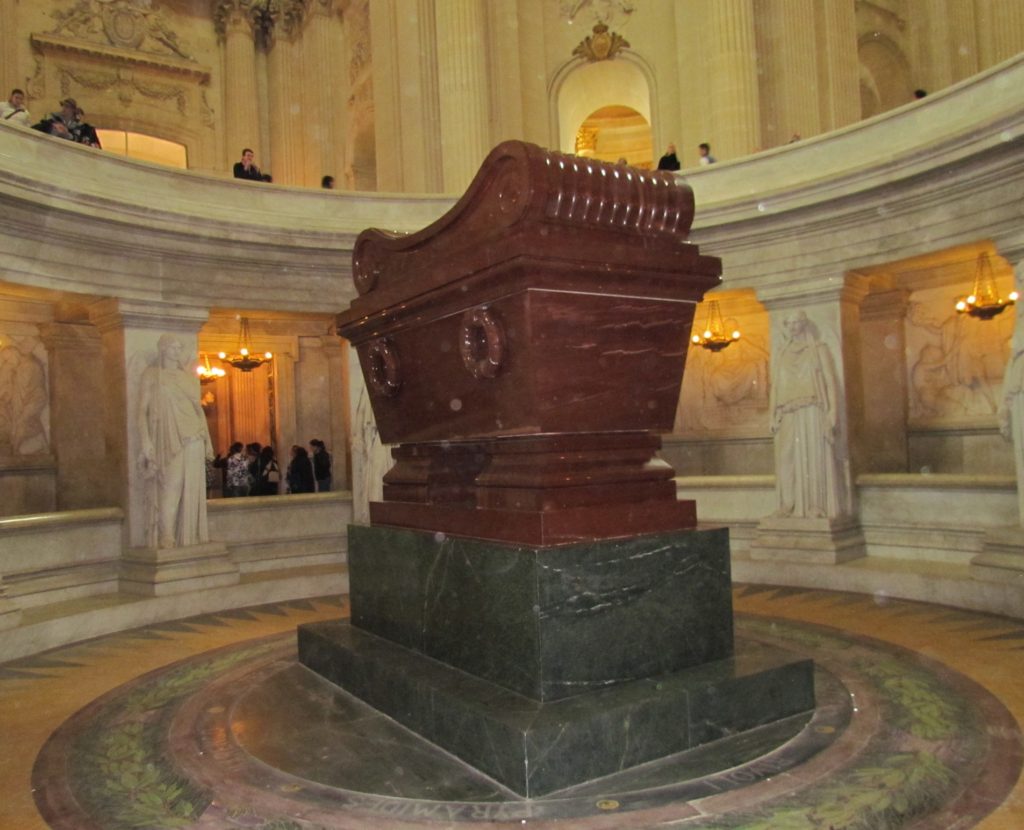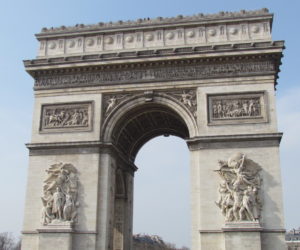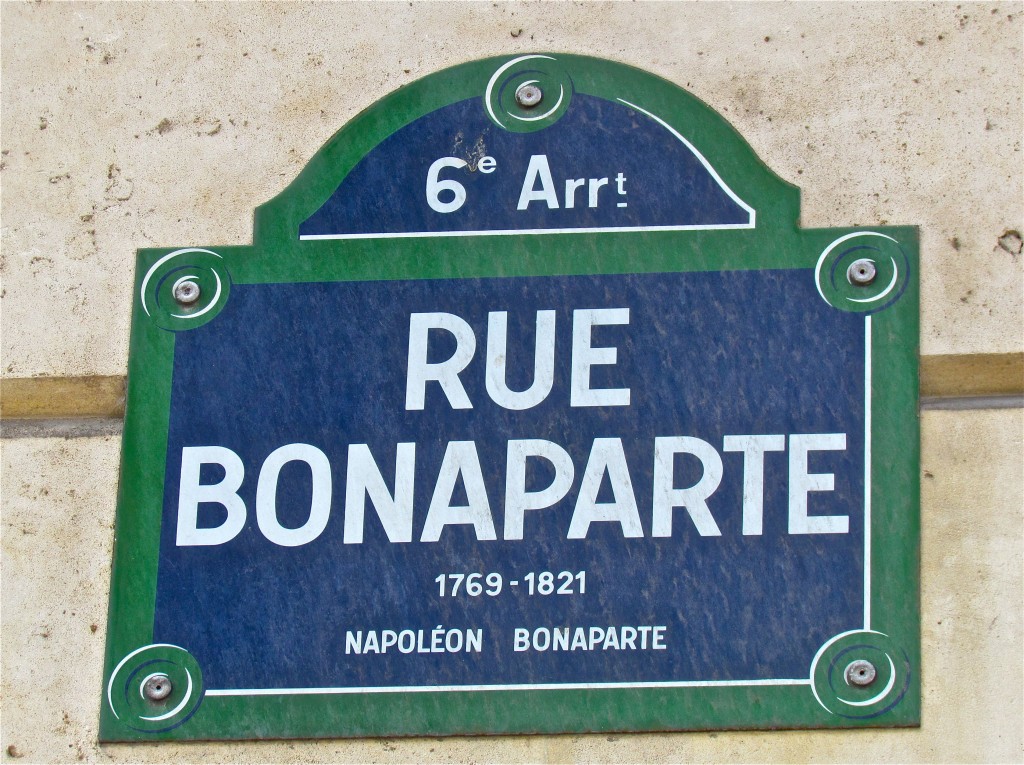Napoleon first became real to me when I visited Paris as a child. My dad was in the US Navy, stationed aboard the Sixth Fleet flagship. While he was mostly at sea, my family lived in lovely Villefranche-sur-mer on the Mediterranean coast. We cherished our time in France and traveled as much as we could afford. That led to my first “Finding Napoleon in Paris.”

On a family visit to Paris, I remember my parents debating the architecture of Les Invalides. Was it a good decision to have Napoleon’s sarcophagus on the lower level so visitors looked down upon it (my mother’s opinion)? Or should it be on the main floor where it would be more imposing (my father’s opinion)? That discussion seemed so intense to me. Remembering it decades later, I would have sworn the tomb had been a current controversy, not a design finished more than a hundred years prior. Napoleon does that to people.
I’ve been lucky enough to visit Paris many times since then. In recent years, it was as an author conducting research. That included day trips to Brienne (the site of Napoleon’s early schooling), the chateau of Fontainebleau (which housed eight centuries of French rulers including Napoleon), and the Chateau de Malmaison (Josephine’s final home and a museum dedicated to Napoleon’s First Consulate period). Because of my years there as a youngster, I feel at home in France–even though my French is far from fluent.
Here’s a five-minute slideshow of the Paris region from my Napoleonic perspective :
What Paris meant to Napoleon Bonaparte
Although born in Corsica, nine-year-old Napoleon Bonaparte came to mainland France on a scholarship to the military school at Brienne, 135 miles east of Paris. He probably saw Paris for the first time in 1784, when, at fifteen, he attended the École Militaire, the officers academy not far from Les Invalides. In my novel, Finding Napoleon, I get to imagine his first impressions of France’s capital.
For the next thirty years, he lived in or near Paris, except for short stints in Corsica, on military assignment and campaign, and in exile.
The Young Man
- In 1792, as a young officer, he witnessed the storming of the Tuileries Palace. On that night, a revolutionary mob slaughtered the Swiss Guard and humiliated King Louis XVI.
- In 1795, still young but a general, he drafted his novel, Clisson et Eugenie. At that time, he lived in a shabby apartment on Rue de la Huchette across the Seine from Notre Dame.
- On March 9, 1796, he married Josephine Beauharnais. They both lied about their ages so that she wouldn’t appear older than he was.
The Rise to Power

- Returning to Paris in 1799 from his Egyptian Campaign, he staged the Coup d’Etat de Brumaire. As a result, at thirty years old, Napoleon claimed the role of First Consul. Thus, his first civilian position was the highest one in France.
- Over the following five years (divided between Paris and military campaigns), he consolidated his popularity and power. On December 2, 1802, he crowned himself Emperor in Paris’s Notre Dame cathedral.
- Five years later, he divorced Josephine and married Marie Louise, a princess of Austria.
- In 1811, their son—Napoleon’s only legitimate child—was born at the Tuileries Palace. Napoleon stood on the top of the world that day.
The Swift Decline
- Scarcely a year later, he set out from Paris on his disastrous Russian campaign. That marked the beginning of his fall.
- By spring of 1814, foreign troops occupied Paris, and Napoleon abdicated, accepting exile on the island of Elba. King Louis XVIII reigned in Paris.
- Ten months later, on March 20, 1815, Napoleon marched back into Paris. The king fled, and Napoleon recovered his throne without firing a shot. But to defend that throne, he had to go to war.
- On June 18, 1815, Napoleon met defeat at Waterloo. He returned to Paris where he abdicated.
- On June 23, 1815, he left Paris one last time. He hoped to secure sanctuary from the British. Instead, they sent him into exile on remote St Helena Island in the south Atlantic Ocean.
- On December 15, 1840, almost twenty years after his death on St Helena, a golden hearse carried his body through Paris streets for its final interment at Les Invalides.
What Napoleon meant to Paris
Napoleon rarely saw a problem he wasn’t eager to fix. (On his way to invade Egypt, he stopped in Malta for a week and wrote them a new constitution.) Here are a few of the ways he left his mark on Paris:
- Napoleon modernized the delivery of safe water throughout the city.
- After a fire he narrowly escaped, Napoleon transformed Paris’s amateur firemen into a well-equipped, highly trained battalion.
- He professionalized the hospital and health system, adding public medical assistance to the poor.

- Napoleon built many of the monuments that define Paris today: the Arc de Triomphe commemorating his victories, the Vendôme Column covered in bronze from cannon captured at the Battle of Austerlitz; the Arc de Triomphe du Carrousel near the Louvre; the Madeleine church and the colonnades of the National Assembly that face it across the Seine; and the Boulevards des Maréchaux which bear the names of Napoleon’s army marshals.
- He restored and, in 1801, reopened the Louvre, which had become a public museum after the Revolution but closed in 1796 due to disrepair. (He also stocked the museum with the spoils of his conquests, but many of these artistic works were returned to their prior owners after his abdication.)
- Other public works included systematic address numbering of buildings, new bridges, improved streets, and better street lighting.
For all Napoleon’s influence on Paris, there’s not a building, bridge or monument that bears his name. To this day, the only street named after him is the modest, five-block strip on the Left Bank of the Seine in the Sixth Arrondissement called Rue Bonaparte. On one of our trips to Paris, we rented an apartment there.

To find out more about Napoleon and Paris, click here to see my individual posts on Paris.

Good stuff–I look forward to becoming educated on Napolean’s life—
Enjoy the great food and fine wine
Who knew he did’t speak French until he was nine—
Scott
Bon Voyage!!!1
Thanks! We’re at the airport waiting for the flight to South Africa.
Hello Margaret
So what Napoleonic visit did you like most in France? I liked Malmaison very much. I posted some pics of it, and of other sites, in my facebook “L’autre Sainte-Helene” if interested.
Please let me know when your book on Napoleon will be out: I will surely buy a copy !
Albert
Hello, Albert,
I must agree with you–Malmaison was my favorite. It has a human scale and grace that make it very appealing. Unfortunately, I was there in March so the garden wasn’t in bloom. I’ll keep in touch about the progress of my book.
Margaret
Margaret – I am thrilled to find your page. I went on my own Napoleon tour in Paris this summer – a life’s dream come true. I am planning to go to Corsica, Elba and St. Helena in 2021, so I am very interested in your accounts. I was in the Scottish Highlands this summer also and was amazed to find so many Napoleon artifacts – uniforms, paintings, miniatures and writing desks.
Hi, Angela! Glad you found my page. Both those trips sound wonderful–but the 2021 plans are the adventure of a lifetime. Enjoy!
Hello Margaret,
I am fascinated by how you are approaching your analysis of Napoleon. My name is Charles LeMaire. I am American but from a Belgian lineage, Les Bulles, just north of the French border by roughly 20 miles. My father, since passed, has always had a love of our heritage and an interest in France, and thus leading me to a keen interest in a great leader.
I am been to Paris several times but am now, based on your excellent work, very interested in discovering the ” real ” Napoleon, in flesh and blood.
Have you read his dairy notes? Hope you keep on writing ! Are you French?
Charles Robert LeMaire, Esq.
Hello, Charles,
Thanks for writing. No, I’m not French, but my love for France started when I lived there as a young teen. My European heritage comes from many countries that were enemies of Napoleon: Austria, Wales, and Spain–plus some Irish for good measure. I’ve probably read tens of thousands of pages of his writing and writing about him! Thank you for your support.
All the best,
Margaret
Great tour through Napoleon’s life and the legacy he left in France. Napoleon and Josephine are France.🎶
Thanks, Maria. You can probably tell that I love doing research in France.
Margaret
As I , you may enjoy the Victor Cronin book : Napoleon: An Intimate Biography. I am searching for a list of sites in Paris to view personal Napoloeon artifacts and you may recommend a Paris guide who conducts this type of Napoleon tour. Your information is very helpful.
I love the Victor Cronin book! I’ve never found a guide or guidebook devoted to Napoleonic sites in Paris. (Maybe we should write one.I’m game.) You might check out Napoleon.org to see what articles they may have published on the subject, plus for current goings-on. Have a wonderful trip and send me your favorite photo!
Margaret
Pingback: WELCOME! - Margaret Rodenberg
Le corps de Napoléon est-il vraiment aux Invalides? Voir l’enquête du journal Le Gaulois en 1887:
https://gallica.bnf.fr/ark:/12148/bpt6k5262697.item
Un autre mystère napoléonien. On ne sait jamais!
Pingback: FINDING NAPOLEON - Margaret Rodenberg